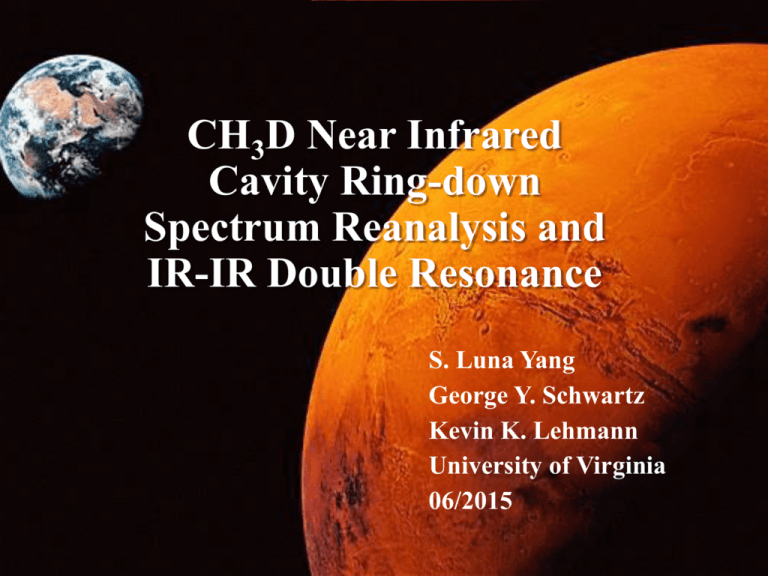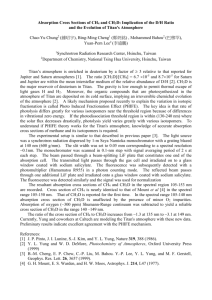Microsoft PowerPoint 2007
advertisement

CH3D Near Infrared Cavity Ring-down Spectrum Reanalysis and IR-IR Double Resonance S. Luna Yang George Y. Schwartz Kevin K. Lehmann University of Virginia 06/2015 Outline Motivation for studying methane isotopomers Experimental setup of cavity ring-down spectroscopy (CRDS) Spectrum analysis of CH3D - spectrum simulation - combination differences - temperature dependence - double resonance Future plan and acknowledgement Credit: NASA, 2009 Scientific American 296, 42 - 51 (2007) Methane isotopes CH3D Applied Optics, Vol. 33, Issue 33, pp. 7704-7716 (1994) Outline Motivation for studying methane isotopomers Experimental setup of cavity ring-down spectroscopy (CRDS) Spectrum analysis of CH3D - spectrum simulation - combination differences - temperature dependence - double resonance Future plan and acknowledgement Experimental setup for CRDS methane detection DFB diode Lasers #1 TECs #2 MOS #3 Current Sources PC #4 70MHz Beam Splitter EOM Single Pass Cell Detector #2 Pulse Generator SOA Mixer Detector #1 M SM1 HeNe SM2 Cavity M PZT OPM Typical CRDS spectrum of CH3D at near infra-red region Cavity ring-down spectroscopy of ~177 ppm CH3D in ~ 8.3 Torr N2 buffer gas, in comparison with FTIR spectrum (76.7 Torr pressure, 105 m absorption path length ). FTIR spectrum : K. Deng et al, Molec. Phys., VOL. 97, NO. 6 (1999). Outline Motivation for studying methane isotopomers Experimental setup of cavity ring-down spectroscopy (CRDS) Spectrum analysis of CH3D - spectrum simulation - combination differences - temperature dependence - double resonance Future plan and acknowledgement 1. Spectrum simulation - comparison Comparison of CH3D CRDS spectrum with software simulation and FTIR spectrum FITR: Mol. Phys. 1999 2. Combination differences - theory If two transitions are from different ground states but both go to the same overtone band state, J , K J , K and J , K J 1,K , their frequency difference is: H (J 1,K ) H (J ,K ) 2B(J 1) 4D J (J 1)3 2D JK (J 1)K 2 4H JK (J 1)3 K 2 2H KJ (J 1)K 4 +… The relative intensities of combination differences can also be predicted. 3. Temperature dependence - theory Line intensity of a certain transition for spherical top molecules have the following dependence on temperature (when neglecting vibrational energies and perturbations): I C(2J 1)e E / KT T 3 / 2 Therefore, if we have the line intensity under two different temperatures, their ratio would be: E 1 1 T2 I1 exp I2 K T1 T2 T1 I 3 T ln 1 ln 2 I 2 T1 E 2 1 1 T2 T1 3 2 The ground state energy, mostly rotational energy, can be estimated: E=BJ(J+1)+(A-B)K2 3. Temperature dependence - test CH4 Q-branch Methane spectrum line intensity temperature dependence (CH4 Q branch) 3. Temperature dependence - test CH4 Q-branch Methane CH4 ground state rotational energy comparison between approximation and temperature dependence experimental result 4. Double resonance -setup C-H stretching bands of CH3D … 1 0 : Fundamental band, near 3000 cm-1, well studied 2 0 : First overtone band, near 6000 cm-1, much more 3 complicated and not well studied Increase absorption 2 probe laser 1 pump laser 0 Decrease absorption Pump laser: CW Optical parametric oscillation (OPO) output wavenumber ~3000cm-1 output power > 1W. ∆ν͌1MHz Probe laser: DFB diode laser output wavenumber ~6000cm-1 output power ~10mW. ∆ν͌10MHz 4. Double resonance - result Pump laser transition RQ0(8) Pump laser transition RQ0(5) • Found about 100 sharp positive&negative peaks from double resonances for different transitions. • Improved simulations to be more accurate – the simulation and calibrated wavenumber of assigned peaks are within 0.004 cm-1 difference. • Found transitions from other bands that are not yet simulated. 4. Double resonance - four features Cell: ~300 mtorr pure CH3D Sharp negative peaks: The pump laser excites CH3D RR1(1) ν=1←0 transition at 3034.688 cm-1 . Broad negative peaks: Correspond to that the probe laser excites molecules ν=2←0. Cell: ~1torr pure CH4. Sharp positive peaks: The pump laser excites CH4 R(0) ν=1←0 transition at 3028.726 cm-1, and the probe laser excites molecules ν=3←1. Broad positive peaks: Vibrational heating effect of pump laser beam Vibration-rotational parameters for simulating 2 4 ( A1 ) and 2 4 ( E ) bands (unit cm-1) Parameter Ground state 2 4 ( A1 ) 2 4 ( A1 ) 2 4 ( E ) 2 4 ( E ) ν - 5980.404(8) 6022.203(4) A 5.250821 5.242(1) 5.2134(7) B 3.880195 3.862(1) 3.8506(3) DJ/10-5 5.2614 -1.5(4) ×10 4.8(7) DJK/10-4 1.26287 -1.6(2)×10 2.6(2) DK/10-4 -0.78844 3.4(2)×10 -2.3(3) HJ/10-9 1.394 - 1.0(5)×102 HJK/10-8 1.146 - 3.9(2)×102 HKJ/10-9 -6.58 - 3.9(4)×102 HK/10-9 -1.05 - -2.9(4)×103 Aζ - - -0.1021(1) ηJ/10-3 - - 1.26(2) ηK/10-3 - - 1.20(5) qeff/10-2 - - -1.59(2) qeffK/10-3 - - - - - - /10-3 Outline Motivation for studying methane isotopomers Experimental setup of cavity ring-down spectroscopy (CRDS) Spectrum analysis of CH3D - spectrum simulation - combination differences - temperature dependence - double resonance Future plan and acknowledgement Future plans • CH3D spectrum at an intermedia temperature • ‘Ladder’ double resonance assignment • Liquid nitrogen cooled double resonance • Double resonance in CRDS Acknowledgements •NSF •NASA •University of Virginia •Yongxin Tang









